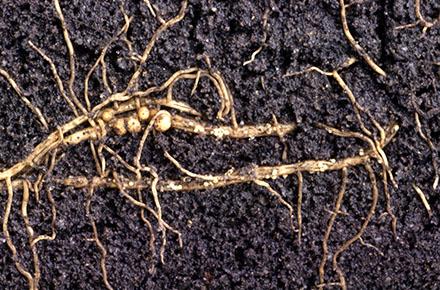USA
December 3, 2024

Female soybean cyst nematodes feed in plant roots and form bulbous, egg-filled nodules from which young will hatch the following spring. (Photo by Keith Weller)
Scientists with the Agricultural Research Service (ARS) are stepping up their efforts to control agricultural pests, without the use of chemical pesticides. One promising solution are fungi carried by the pests themselves in a symbiotic relationship.
Invertebrate pests, including nematodes and arthropods (insects, mites, etc.), cause tremendous crop loss each year. According to Kathryn Bushley, microbiologist with the ARS Emerging Pests and Pathogens Research Unit in Ithaca, NY, just one pest – the soybean cyst nematode, an invasive parasite that attacks soybean roots – causes over $1 billion of damage each year in the United States.
Harnessing beneficial fungi that target these nematodes could be a solution.
“We are investigating natural ‘insect-killing’ fungi to try to control the ability of these pests to damage crops or vector (transmit) plant diseases,” Bushley said. “These fungi, as well as their genes/DNA and the chemicals they produce, [are] more environmentally sustainable approaches to managing agricultural pests, plant pathogens, and parasites than using pesticides.”
Bushley’s project examined the symbiotic relations of nematode pests and the fungi they carry. The researchers discovered that some of these fungi can infect soybean cyst nematode eggs or trap the juvenile worms as they move through soil with “sticky traps.” Other fungi can help control the soybean cyst nematode by either preventing the nematode from infecting a plant or inhibiting its development inside the plant.
U.S. soybean growers have faced fluctuating soybean prices and economic challenges in recent years, making reduction of yield loss critical. According to Bushley, many chemical pesticides are either banned or rapidly losing effectiveness, and that drives the need for other solutions to help manage the soybean cyst nematode.
“Once infesting a farmer’s field, the soybean cyst nematode produces cysts that contain hundreds of eggs that can survive and hatch for up to 10 years,” she said. “My lab is identifying and testing fungi and bacteria that can parasitize (infest) the eggs, produce metabolites that could kill nematodes, and be developed as biopesticides to help control nematode populations.”
Bushley explained that the transmission of plant pathogenic microbes by arthropods is one of the major ways that plants get sick. Managing the plant disease often means targeting the insects that transmit them. Arthropods and other invertebrates, such as nematodes, are difficult to control as they reproduce rapidly, are mobile, and can often evolve resistance to chemical pesticides.
“Microbes associated with insects, and other invertebrates such as nematodes, play a major role in the success of these pests,” she continued. “Some symbionts of insects, for example, can influence the resistance of their insect host to pesticides, while natural pathogens of pests are promising control agents. By better understanding the roles microbes play in the lives of agricultural pests, we can better manipulate them to manage these pests.”
Information from the study has been added to the ARS Collection of Entomopathogenic Fungal Cultures, the largest collection of fungi that are either pathogenic or symbiotic with insects and other invertebrate pests. The collection includes over 12,000 living fungi and associated metadata that researchers worldwide can use to develop potential biological control agents of agricultural pests.
“We aim to develop approaches to control arthropod pests or the diseases they vector,” Bushley said. “We plan to develop some of the natural parasites of nematodes as either seed coatings or soil treatments for application to a farmer’s field. The ideal application method is one that can be incorporated into existing workflows and machinery that farmers typically use already in managing their crops.”
The project offers hope for the development of more environmentally friendly solutions to invertebrate pests and the plant pathogens they vector, Bushley said. “As plant doctors, we may not always be able to completely cure or eliminate all pests once they’ve established, but by using a variety of approaches, including microbial biocontrol as part of an integrated pest management scheme, we can control the disease sufficiently to improve crop yields and farmers’ profit margins. Our goal is to develop environmentally and economically sustainable alternatives that solve these challenges.
“I think it’s exciting to think about using nature’s own toolbox, such as natural microbial pathogens to target invertebrate pests in agriculture,” Bushley said. – by Scott Elliott, ARS Office of Communications